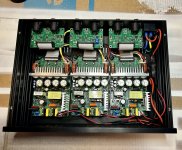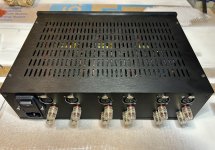Yes I’m using a three prong plug. I haven’t installed my FFA001 amp in a chassis yet so Im not sure what I’ll use for power inlet but on previous class D amp builds I’ve used those all in one switched/fused/filtered iec power entry modules like this 10a Power entry module . I don’t pay $40 for them though, if you search around surplus sellers you can find them for under $20.Are you using a three prong plug? So far I'm using a 2 prong. What's the recommendations for power inlet?
Hello Eric
Does your amplifier require a grounded enclosure for EMI/EMC and safety or is a 2 prong power cord (double insulated without ground) ok ?
Thanks
Eric
Does your amplifier require a grounded enclosure for EMI/EMC and safety or is a 2 prong power cord (double insulated without ground) ok ?
Thanks
Eric
Merry ChristmasHello Eric
Does your amplifier require a grounded enclosure for EMI/EMC and safety or is a 2 prong power cord (double insulated without ground) ok ?
Thanks
Eric
 to you and all my friends~
to you and all my friends~Under our big customer's user scenario, this module was mounted into a grounded enclosure, and they pass all the certification tests.
For personal use, considering SAFETY, I think the double insulation is ok, but I do not have the data of the EMI/EMC. I happened to see one thread here that mentioned the running amplifier does not interfere with his radio, this also confirms that this module can run perfectly without an EMC issue in an open-frame scenario.
Thanks,Eric
Merry Christmas
For safety requirements every metallic enclosure need to be grounded.
Erica used mounting holes of FFA001_V3 for ground connection.
On amp and smps pcb near main rectifier and three blue capacitors it is connection for EMI filter ground, you need to use that connection for optimal EMI filtration.

Between small heatsink and big capacitors it's another direct connection to ground.

Other three mounting holes are connected to ground with some small white smd (I think they are capacitors).

On buffer pcb two holes are connected after a "ground lift circuit" used for input connectors.

Remain three mounting holes without ground connection (at least I wasn't able to find), and two on buffer pcb.
For safety requirements every metallic enclosure need to be grounded.
Erica used mounting holes of FFA001_V3 for ground connection.
On amp and smps pcb near main rectifier and three blue capacitors it is connection for EMI filter ground, you need to use that connection for optimal EMI filtration.
Between small heatsink and big capacitors it's another direct connection to ground.
Other three mounting holes are connected to ground with some small white smd (I think they are capacitors).
On buffer pcb two holes are connected after a "ground lift circuit" used for input connectors.
Remain three mounting holes without ground connection (at least I wasn't able to find), and two on buffer pcb.
Nice work stryx, I’ve done the same investigating to track down what seems to be a ground loop hum I hear. The buffer board has 82R//82R GLB resistors between the signal GND and monting holes.
But the speaker returns on the main board have direct connection to “dirty” earth ground. This could be the source of the noise, I will try to isolate the main board and connect chassis gnd to a single mounting hole with a 10R NTC in series.
But, music does sound very good😉
But the speaker returns on the main board have direct connection to “dirty” earth ground. This could be the source of the noise, I will try to isolate the main board and connect chassis gnd to a single mounting hole with a 10R NTC in series.
But, music does sound very good😉
Last edited:
Mine is quiet , I did use a power entry filter and grounded the chassis to it and grounded the board to the chassis with the standoffs ( cleared anodizing under one on each the amp and I/o board).
Bill
Bill
Today I listen that small amplifier, for his price its sound really good. I don't have any noise oe hum. I used just ground connection just EMI filter so it was impossible to have an ground loop.
Music test on 8 ohm dummy load:

Music test on 8 ohm dummy load:
IMO, when testing an amplifier either acoustically or electrically, results are what they are, regardless of it's purchase price.Today I listen that small amplifier, for his price its sound really good.
Price enters the picture later at the evaluation stage as one more parameter to influence our opinion as to what we might tolerate from the (possible) less than good test results.
George
if there is a contest in diyaudio.com to vote for the best said statement of 2022, i will vote for this one.IMO, when testing an amplifier either acoustically or electrically, results are what they are, regardless of it's purchase price.
Price enters the picture later at the evaluation stage as one more parameter to influence our opinion as to what we might tolerate from the (possible) less than good test results.
George
IMHO it's a good amplifier. It isn't the best or worst amplifier I listened, but it's good one.
For me cost-quality(performance) ratio is the most important.
For me cost-quality(performance) ratio is the most important.
Here are some summary details of my build in case it's helpful reference for others:
- Chassis is a Galaxy 2U 330x230, with full vented top and bottom from the diyAudio Store
- Modushop cut the IEC opening and screw holes as part of my order
- Three FFA001 modules plus the XLR I/O boards from the beginning of this thread are in the chassis
- There is JUST enough room or all this laid out flat in the chassis I have (though the I/O boards are mounted above the amp modules so that there is room for XLRs above and speaker binding posts below
- Mains inlet is a Schurter 4304.6090
- Mains earth ground is connected to the chassis (with anodizing sanded away)
- Mains AC is connected in parallel to the three modules
- XLR input openings/mounting hole screws and speaker binding post holes are hand drilled
- Fan(s) were tried but not successfully implemented due to spacing and noise issues
- Eric has addressed the noise and voltage issues with fan circuit in the updated I/O boards, which I have not tried (https://www.diyaudio.com/community/threads/2x150w-amp-module-for-sale.388868/post-7181561)
- Three modules in my chassis get warm under normal use, but not worryingly so (I have no concerns about the heat in my build)
- XLR-to RCA adapters work fine for me (https://www.amazon.com/gp/product/B07RQNGDF2/)
- The build performed very well in my main stereo rig and sounds very good
- I tested the build with a MiniDSP Flex Eight for multi-channel experimentation and it worked well
Attachments
An additional point that might be helpful for those with noise issues: all my boards are isolated from the chassis. The amp boards are on nylon standoffs, and the Neutrik XLRs are attached to the chassis through their plastic housing.
Nice build summery von Ah 😉
After some experimenting the hum was reduced to barely audible level with my ear right to the speaker, a non-issue now.
The amp and buffer boards are isolated from the chassis with nylon standoffs. Earth ground connects to chassis floor direct from Schurter AC inlet module DD22.1121.1111.
A 10R NTC from the chassis mounting hole (between the small heatsink and bulk capacitor) attaches to the same chassis bolt as Earth GND connection.
After some experimenting the hum was reduced to barely audible level with my ear right to the speaker, a non-issue now.
The amp and buffer boards are isolated from the chassis with nylon standoffs. Earth ground connects to chassis floor direct from Schurter AC inlet module DD22.1121.1111.
A 10R NTC from the chassis mounting hole (between the small heatsink and bulk capacitor) attaches to the same chassis bolt as Earth GND connection.
I put amplifier in some aluminium box and grounded all mounting holes and.... noise, no hum, no nothing, just deep silent.
Can I ask what a 10R ntc is and how it helps here?Nice build summery von Ah 😉
After some experimenting the hum was reduced to barely audible level with my ear right to the speaker, a non-issue now.
The amp and buffer boards are isolated from the chassis with nylon standoffs. Earth ground connects to chassis floor direct from Schurter AC inlet module DD22.1121.1111.
A 10R NTC from the chassis mounting hole (between the small heatsink and bulk capacitor) attaches to the same chassis bolt as Earth GND connection.
what-is-an-ntc-thermistor
The NTC creates a simple form of ground loop breaker by introducing some resistance to the signal ground connection.
Thanks for thatwhat-is-an-ntc-thermistor
The NTC creates a simple form of ground loop breaker by introducing some resistance to the signal ground connection.
I have a board on the way also. What are my options for an enclosure that won’t cost more than the parts? Can’t wait to build this up, sounds as if it’s going to be a good investment.
- Home
- Vendor's Bazaar
- 2x150W Amp module for sale


